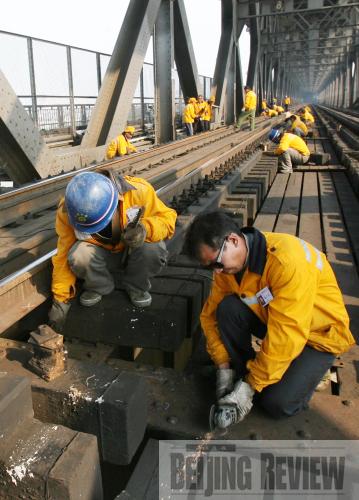|
 |
|
TIMELY REPAIR: Railways need to be checked regularly to prevent accidents. The picture shows workers replacing rivets in the Wuhan Yangtze River Railway Bridge (ZHOU GUOQIANG) |
60 years of construction
The Chinese railway's history spans 133 years, from the Shanghai-Wusong Railway that started running in 1876. But the construction boom only started in earnest in the 60 years after the founding of the People's Republic of China.
By the time when New China was founded in 1949, about 21,800 km of tracks had been laid across the country, and only 11,000 km was functioning. Xiang Chun, a researcher at the Ministry of Railways, said in 1950 the government decided to fill the void in the western part of the country. Construction began on the Chengdu-Chongqing, Tianshui-Lanzhou and Lanzhou-Urumqi lines, which marked the beginning of massive Chinese railway construction projects.
Chinese railway construction underwent three phases in the ensuing 60 years.
1953-1981: the first wave of railway construction
China released its first five-year economic plan in 1953, and massive railway expansion ensued. By 1965, the length of railways in operation had reached 38,025 km, rising 74.3 percent from 1949. At the same time, China completed construction of the Wuhan Yangtze River Bridge, the first railway bridge to cross the river.
In 1966, the country was in the middle of the economically debilitating "cultural revolution," but railway construction never abated. From 1966 to 1980, major railway connections were established in spite of the harsh domestic condition, including the Guiyang-Kunming, Chengdu-Kunming, Xiangfan-Chongqing and Taiyuan-Jiaozuo lines.
Numerous disasters beset the building of the Chengdu-Kunming Railway. Workers encountered landslides, tunnel collapse, debris flow and toxic gas. In spite of the obstacles, China successfully finished the line.
Between 1950 and 1981, China built 105 railway lines, and the length of railway lines in operation on the Chinese mainland had grown to 50,181 km by the end of 1981.
1982-1996: construction accelerated by economic development
The economic takeoff following the country's reform and opening-up in 1978 drove up railway construction efforts.
"After reform and opening up, the rapid economic development intensified railway passenger and cargo flow, which then prompted the government to build more railways to absorb the soaring number of travelers using the transport network," said Xiang Chun.
Shanxi Province was rich in coal but trying to move the resource out of the region created a bottleneck that clogged its development. In September 1983, the State Council, China's cabinet, decided to build the Datong-Qinhuangdao Railway to connect Shanxi's coal production base with Hebei Province's port city of Qinhuangdao. The major construction project was the first railway line built to solve resource transportation problems. The line, which began construction in 1985, was completed in 1991.
The Datong-Qinhuangdao Railway enables coal produced in Shanxi, Inner Mongolia and Shaanxi to be moved to China's northern, eastern, southern and northeastern regions. It greatly eased coal shortages in those areas and helped boost exports of the fuel.
With the progress spurred by reform and opening-up, increasing passenger flow added more pressure to the railway network. The Chinese Government launched a campaign to build 12 railway projects, like the Beijing-Kowloon Line that runs all the way from the north to the south. A number of double-track and electrified railways were laid down during this period.
By the end of 1996, the total length of Chinese railways had reached 64,900 km. They created a comprehensive network that connects the north to the south and the east to the west.
1997-present: development of high-speed train routes
Before 1997, the trains' maximum speed reached 120 km per hour, averaging just 48 km per hour. The rapid development of highways threw slow-moving railways behind. As a result, the Ministry of Railways focused on development in the new century.
| 
